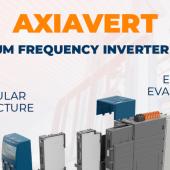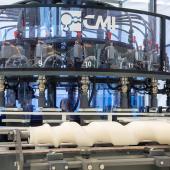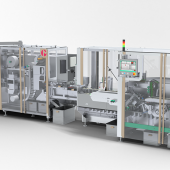Food packaging: aluminium foil and aluminium foil trays
The company Carcano Antonio SpA and the Laminazione Sottile Group have sponsored a joint study to determine the quantity of aluminium present in some foodstuffs, as well a the migration quotas of the aluminium packaging of the self-same foodstuffs.
Without presuming to be exhaustive on such a complex subject, the scientific rigour adopted in the test phase makes it a virtually unique document regarding results achieved and the values expressed on the potentialities of aluminium in preparing and preserving foodstuffs.
ALUMINIUM IN FOOD
Given that aluminium is abundantly present in nature, water and food, human beings are highly exposed to this element (or its compounds) through breathing, skin contact and ingestion.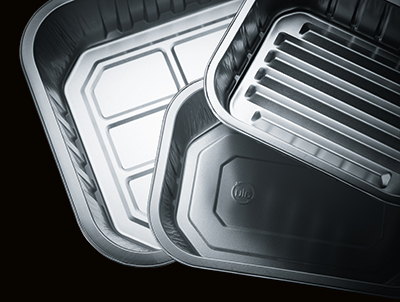
Many medical and scientific research studies carried out in order to evaluate the toxicity of aluminium introduced in “high doses” in animals and humans through various introduction sources (mostly hematic and gastro-enteric) have yielded results certainly inconclusive and often contradictory [3][9][10].
It is obvious that any product, in high doses, will damage human beings – ingestion of 1 kg of kitchen salt will certainly cause death, given that the oral toxicity of sodium chloride, measured as LD50 on rats*, is equal to 3 g/kg bodyweight. No toxicology limits have been set for aluminium (“not hazardous” according to Directive 67/548/EEC), whereas oral toxicity of aluminium oxide has been established as LD50 >2 g/kg bodyweight.
Due to the elevated amount of aluminium present in various food and medical items** (anti-acids, vaccine adjuvants, etc.) as well as in cosmetic and beauty products, European Food Safety Authority (E.F.S.A.) based in Parma, Italy and which, alongside the Health Ministries of the EU member countries is in charge of the oversight and protection of EU citizens’ health, has issued a scientific opinion and requested that the amount of aluminium orally ingested with food be limited to 1 mg/kg bodyweight per week [1].
This means that the dietary aluminium intake of an individual who weighs 60 kg should not exceed 60 mg per week.
PURPOSE OF ALUMINIUM FOILWARE MIGRATION TESTS
The need to obtain new scientific data on the interaction between aluminium and foodstuffs has induced two companies (Carcano Antonio SpA e Laminazione Sottile SpA) leaders in the production of aluminium foil and aluminium foil pans used in food packaging, to sponsor a targeted research study on the topic.
The research was commissioned to an accredited chemical lab (Neotron - Accredia, in compliance with UNI CEI EN ISO/IEC 17025:2005), that has used an ICP (plasma emission spectroscopy) as analysis tool. In a nutshell, the objective of the study was to find out the leaching rates of metallic aluminium from packaging to food, by testing the food after use in normal household conditions: cooking or storage in aluminium foil or aluminium trays [4][5].
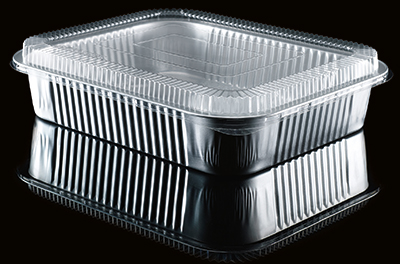 Aluminium semirigid containers (trays) testing
Aluminium semirigid containers (trays) testing
The tests were carried out using aluminium foil pans in EN AW-8006 - an alloy much used in the sector because it represents a good balance between “the required pan rigidity” and its “shapability” [6][7] - provided by the standard production stock at Pignataro Maggiore - a company of the Laminazione Sottile Group.
In choosing the food, we favoured typical Italian dishes: lasagne, chicken and potatoes, fish fillet
Cooking was carried out in traditional ovens under the following conditions:
lasagne 180°C for 30 minutes
chicken and potatoes 200°C for 60 minutes
fish fillet 180°C for 25 minutes
cooling time for all three dishes: 40 minutes.
The lab chosen for testing has also provided for the cooking of “control” dishes: the same food cooked in ceramic cookware, in order to measure the amounts of aluminium already present in food before it came into contact with the tray.
The values obtained were then subtracted from those measured in the food cooked in aluminium pans.
Table 1 contains a summary of the test results.

* LD50. The dose of a liquid or solid substance required to kill half the members of a tested population (e.g. mice or rats) after a specific test.
** For medical products the Food and Drug Administration established, in year 2000, a tolerance limit of 25 micrograms per litre).
Aluminium house foil testing
These tests were carried out on 0.030 mm aluminium foil in EN AW-8079 alloy produced by Carcano Antonio SpA.
The foodstuffs were selected from among those most commonly wrapped in aluminium foil for storage purposes: hot-dog sandwich, semi-soft cheese, sliced ham, eggplants parmigiana, extra dark chocolate, white chocolate with hazelnuts.
Storage conditions were as follows:
- hot dog 40 °C for 24 hours
- cheese 5 °C for 3 days
5 °C for 10 days
- sliced ham 5 °C for 3 days
- extra dark chocolate 20 °C for 10 days
- white chocolate with hazelnuts 20 °C for 10 days
- eggplant parmigiana Cooked in traditional oven
Even in this case each product was tested before coming into contact with the foil, in order to establish the amount of metallic aluminium already present in the food.
Table 2 contains a summary of the test results.

FOOD INTAKE HYPOTHESIS AND CALCULATION OF ALUMINIUM INGESTED PER WEEK
a) Trays
For products cooked in pans, the amounts of aluminium leached from the containers were:
- 0.29 mg/kg in lasagne;
- 0.168 mg/kg in chicken and potatoes;
- 0.052 mg/kg in fish fillet.
Should an individual eat food always cooked in aluminium tray for lunch and dinner; and have a first course of lasagne twice a day and a different second course for lunch and dinner (alternating chicken and fish) for seven days a week, the amount of aluminium intake due to the use of semi rigid containers would be equal to 0.56 mg of Al/week.
A diet of this type would amount to 2,000/2,500 Kcal/day, which is a reasonable amount for aged and slightly overweight populations.
For a subject weighing 60 kg, in whose case EFSA. precautionarily advises to not exceed 60 mg/week, the maximum intake due to the constant use of aluminium pans would amount to about 0.9%.
b) Aluminium foil
Let’s add, to the above-specified diet, the following foodstuffs:
- one 100-g hot dog stored in aluminium foil for 24 hours, about 250 Kcal;
- 100 g of provolone cheese stored for 3 days in the fridge, wrapped in aluminium foil, about 370 Kcal;
- 100 g of provolone cheese stored for 10 days in the fridge, wrapped in aluminium foil, about 370 Kcal;
- 100 g of ham stored for 3 days in the fridge, wrapped in aluminium foil, about 300 Kcal;
- 100 g of eggplant parmigiana cooked al cartoccio in aluminium foil, about 500 Kcal.
These would add another 1790 Kcal + 2500 Kcal, for a total of 4,290 Kcal/day: an overly excessive amount.The use of aluminium foil would provide an additional 1.78 mg/week which, combined with the amount provided by the pans, would reach a total of 2.34 mg/week, i.e. about 3.9% of the 60 mg/week recommended by EFSA. Now let’s calculate the total amount of aluminium ingested, by adding the amounts contained in various foodstuffs and the amounts due to packaging (based on 100 g portions).The total amount of aluminium ingested would result equal to about 5.7 mg/week, i.e. less than 10% of the doses precautionarily recommended by EFSA.
Table 3 contains a summary of these calculations.
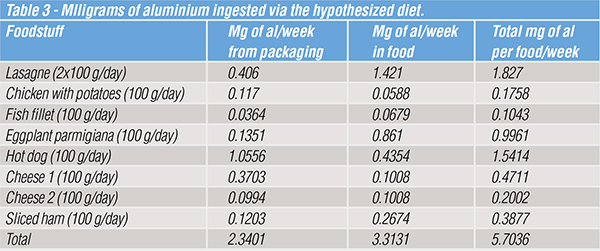
SUMMARY OF RESULTS
By carrying out the tests above and reproducing, in lab conditions, the cooking and/or storing conditions usually adopted by consumers in their everyday practice, we were able to find that the amount of metallic aluminium leached from packaging to the foodstuffs is positively very low: between 2 and 3 mg of Al/week.
Even by adding to this the amount of aluminium already present in food, the values thus obtained are decidedly lower than those recommended by EFSA.It is important to point out that the hypothesis made in the present research provides for the exclusive use of aluminium containers and foils in the cooking and storage of foodstuffs, as well as for a hyper-caloric diet (over 4,000 Kcal/day). Based on these premises, the total contribution of metallic aluminium (amounts contained in the food plus amounts leached from the packaging material) was measured to be 5.7 mg/week: an amount absolutely lower than the value recommended by EFSA (less than 10% of said amount, for an individual weighing 60 kg).
CONCLUSIONS AND RECOMMENDATIONS
It should be dutifully reiterated that, based on the results of several medical and toxicological studies, only people undergoing dialysis or those suffering from severe renal failure are advised to not make excessive use of aluminium packaging (some drugs administered to people under dialysis contain aluminium, which could have a cumulative effect on certain organs)[11].
For the healthy population (it is estimated that over 95% of the ingested aluminium is excreted renally) [7] [11] there is no counter-indication to the use of items in aluminium or its alloys in cooking; and aluminium remains, due to its being practical, as well as for its hygienic and safety properties, among the most suitable materials for the cooking and the storage of many foodstuffs.
Consumers are advised to avoid keeping heavily salted and very acidic food in longterm contact (over 24 hours, especially in room temperature) with aluminium (as it is indicated, by the manufacturers and/or distributors of aluminium packaging materials, on their product labels, in compliance with Ministerial Decree no. 76 of 18.04.2007). A reminder lastly that in Europe aluminium is regulated in France by a “dated decree” (Arrêté du 27 Aôut 1987). Italy is the only country in the EU to have completely and specifically disciplined the subject via Ministerial Decree no. 76 of April 18, 2007, which provides a Regulation regarding the hygiene requirements for materials and items in aluminium and aluminium alloys bound to come into contact with food.
Aluminium: properties, diffusion, recycle
Among the utensils used by millions of people for cooking their food, keeping it fresh and improving its storage, aluminium foil and aluminium foil trays number among the most widespread.
The success of aluminium as food packaging material is related to its multiple properties: resistance to both high cooking temperatures and low freezing temperatures, low weight, impermeability, an excellent barrier to oxygen, light and micro-organisms, aesthetically pleasant, infinite (and highly profitable) recyclability.
Due to its remarkable chemical reactivity, aluminium is almost never found, in nature, in its elemental state; but it abounds in the form of numerous compounds, such as bauxite or kaolin, which make up a considerable part of the Earth’s crust (about 8%): it is the third most diffused element and the first among metals.
The aluminium production process consists of two consecutive cycles: the first of a chemical nature, which transforms bauxite into alumina or aluminium oxide (Al2O3), and the second of an electrolytic nature, in which alumina is reduced into metal through the use of large amounts of electricity (about 15 KWh/Kg on the average).
Aluminium recycling, instead, is very convenient economically, because it only requires 0.7 KWh/Kg (about 1/21 of the energy needed for electrolytic smelting); and the metal thus obtained (secondary aluminium) maintains the properties of the primary aluminium.
Aluminium is arguably the most suitable material for recycling: the process is highly profitable and the process can be repeated ad infinitum.
This provides a solution to the waste management problem, while also helping abate emissions and implementing environmental and energy sustainability policies that all governments have adopted for the benefit of future generations [2].
(**) Per i farmaci il limite di tolleranza, fissato nel 2000 dalla Food and Drug Administration, è 25 microgrammi mgAl/l
Raffaella Bonacina, Quality Assurance Manager
Carcano Antonio SpA
Manufacturer of aluminium packaging products, with facilities at Delebio (SO) and Mandello del Lario (LC).
Ciro Sinagra, R&D Manager
Laminazione Sottile SpA
European leader in the production of aluminium foil for trays and single-use containers, with facilities at S. Marco Evangelista (CE); and are part of the Italcoat and Contital group with facilities at Pignataro Maggiore (CE) and I2R, with headquarters at Telford (UK).











